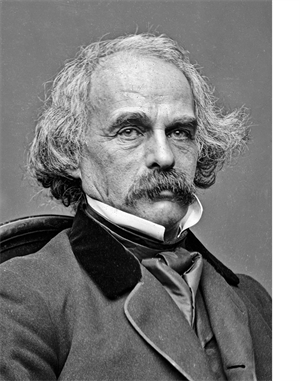PDF chapter test TRY NOW
Nathaniel Hawthorne was an interesting, fanciful Short story writer of American Literature. He was born on July 4, 1804, in Salem, Massachusetts and lived till May 19, 1864. His excellence in composition made him an excellent short story writer after a few years of his graduation. His works focuses more on morality, history and religion. And it centres around New England, featuring moral metaphors with an anti-Puritan inspiration. His first novel, 'Fanshawe' was published in the year 1828 which he felt it to be of low quality, compared with his later novels. He also published some of his short stories in periodicals, collectively called as "Twice-Told Tales".
Most of his fiction works are attributed to the part of the Romantic movement during the nineteenth century, especially, dark romanticism. His themes regularly focus on the inherent evil and sin of humanity, and his works often have moral messages and deep psychological complexity. His published works include short stories, novels, and a biography of his college friend Franklin Pierce, the fourteenth President of the United States.
Most of his fiction works are attributed to the part of the Romantic movement during the nineteenth century, especially, dark romanticism. His themes regularly focus on the inherent evil and sin of humanity, and his works often have moral messages and deep psychological complexity. His published works include short stories, novels, and a biography of his college friend Franklin Pierce, the fourteenth President of the United States.

Nathaniel Hawthorne*
S.No | Hawthorne's major works |
1. | The Hollow of the Three Hills (Short story) |
2. | An Old Woman’s Tale (Short story) |
3. | My Kinsman, Major Molineux (Short story) |
4. | Roger Malvin’s Burial (Short story) |
5. | Young Goodman Brown (Short story) |
6. | The Scarlet Letter (Novel) |
Hawthorne's work involves more of quest and symbolism. The image of "The Great Stone Face" is a symbolic element, which represents an abstract idea, on which Ernest will construct his quest in life. Right from the introductory section of the story, we can easily figure out the elements of symbolism and quest in it.
"The Great Stone Face" symbolizes divine qualities such as nobility, wisdom, greatness, etc. These two elements give life to the whole plot, woven around the protagonist of the story.
Reference:
Nathaniel Hawthorne*: Mathew Brady, Public domain, via Wikimedia Commons
https://en.wikipedia.org/wiki/Nathaniel_Hawthorne#/media/File:Nathaniel_Hawthorne_by_Brady,_1860-64.jpg
https://en.wikipedia.org/wiki/Nathaniel_Hawthorne#/media/File:Nathaniel_Hawthorne_by_Brady,_1860-64.jpg
